Influence of electrode design on actuation characteristics of cooperative DEAP actuators
Konferenz: ACTUATOR - International Conference and Exhibition on New Actuator Systems and Applications 2021
17.02.2021 - 19.02.2021 in Online
Tagungsband: GMM-Fb. 98: ACTUATOR 2021
Seiten: 4Sprache: EnglischTyp: PDF
Autoren:
Zhu, Rui (Institute for Microsystems Technology (IMST), Department of Mechanical & Medical Engineering, Furtwangen University, Furtwangen, Germany & Laboratory for Microactuators, IMTEK – Department of Microsystems Engineering, University of Freiburg, Freiburg, Germany)
Wallrabe, Ulrike; Wapler, Matthias C. (Laboratory for Microactuators, IMTEK – Department of Microsystems Engineering, University of Freiburg, Freiburg, Germany)
Woias, Peter (Laboratory for the Design of Microsystems, IMTEK – Department of Microsystems Engineering, University of Freiburg, Freiburg, Germany)
Mescheder, Ulrich (Institute for Microsystems Technology (IMST), Department of Mechanical & Medical Engineering, Furtwangen University, Furtwangen, Germany & Faculty of Engineering, University of Freiburg, Germany)
Inhalt:
We propose DEAP actuators with segmented electrodes as a new actuation approach e.g. for tactile displays. They provide patterns with adjustable bump size (e.g., bump height, bump area and distance between adjacent bumps) and position by powering the segmented electrodes in a cooperative manner. Additionally, moving patterns can be generated with this dynamic concept. Taking a generic electrode design, we study the dependence of the bump height and length on the applied voltage and number of sequential elements using FEM simulations and experiments. Both show qualitatively a similar behavior. For small numbers of powered electrodes, the deflection of DEAP increases linearly with the length of the powered electrode region, however, the deflection height reaches a saturation value when the length of the powered electrode region is about the membrane width for the actuators. At this point, the length of the bump starts to grow according to the length of the actuated electrodes.


